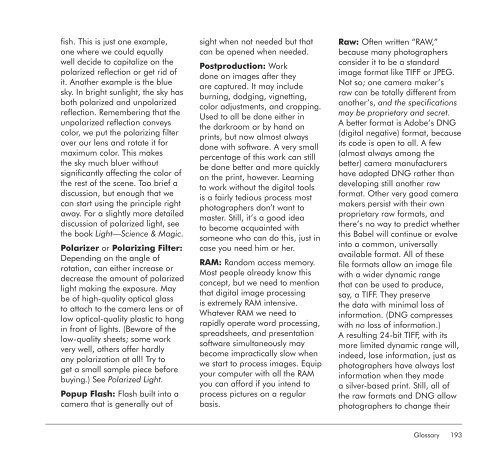Focus On Lighting Photos Focus on the Fundamentals.pdf
Create successful ePaper yourself
Turn your PDF publications into a flip-book with our unique Google optimized e-Paper software.
fish. This is just <strong>on</strong>e example,<br />
<strong>on</strong>e where we could equally<br />
well decide to capitalize <strong>on</strong> <strong>the</strong><br />
polarized reflecti<strong>on</strong> or get rid of<br />
it. Ano<strong>the</strong>r example is <strong>the</strong> blue<br />
sky. In bright sunlight, <strong>the</strong> sky has<br />
both polarized and unpolarized<br />
reflecti<strong>on</strong>. Remembering that <strong>the</strong><br />
unpolarized reflecti<strong>on</strong> c<strong>on</strong>veys<br />
color, we put <strong>the</strong> polarizing filter<br />
over our lens and rotate it for<br />
maximum color. This makes<br />
<strong>the</strong> sky much bluer without<br />
significantly affecting <strong>the</strong> color of<br />
<strong>the</strong> rest of <strong>the</strong> scene. Too brief a<br />
discussi<strong>on</strong>, but enough that we<br />
can start using <strong>the</strong> principle right<br />
away. For a slightly more detailed<br />
discussi<strong>on</strong> of polarized light, see<br />
<strong>the</strong> book Light—Science & Magic.<br />
Polarizer or Polarizing Filter:<br />
Depending <strong>on</strong> <strong>the</strong> angle of<br />
rotati<strong>on</strong>, can ei<strong>the</strong>r increase or<br />
decrease <strong>the</strong> amount of polarized<br />
light making <strong>the</strong> exposure. May<br />
be of high-quality optical glass<br />
to attach to <strong>the</strong> camera lens or of<br />
low optical-quality plastic to hang<br />
in fr<strong>on</strong>t of lights. (Beware of <strong>the</strong><br />
low-quality sheets; some work<br />
very well, o<strong>the</strong>rs offer hardly<br />
any polarizati<strong>on</strong> at all! Try to<br />
get a small sample piece before<br />
buying.) See Polarized Light.<br />
Popup Flash: Flash built into a<br />
camera that is generally out of<br />
sight when not needed but that<br />
can be opened when needed.<br />
Postproducti<strong>on</strong>: Work<br />
d<strong>on</strong>e <strong>on</strong> images after <strong>the</strong>y<br />
are captured. It may include<br />
burning, dodging, vignetting,<br />
color adjustments, and cropping.<br />
Used to all be d<strong>on</strong>e ei<strong>the</strong>r in<br />
<strong>the</strong> darkroom or by hand <strong>on</strong><br />
prints, but now almost always<br />
d<strong>on</strong>e with software. A very small<br />
percentage of this work can still<br />
be d<strong>on</strong>e better and more quickly<br />
<strong>on</strong> <strong>the</strong> print, however. Learning<br />
to work without <strong>the</strong> digital tools<br />
is a fairly tedious process most<br />
photographers d<strong>on</strong>’t want to<br />
master. Still, it’s a good idea<br />
to become acquainted with<br />
some<strong>on</strong>e who can do this, just in<br />
case you need him or her.<br />
RAM: Random access memory.<br />
Most people already know this<br />
c<strong>on</strong>cept, but we need to menti<strong>on</strong><br />
that digital image processing<br />
is extremely RAM intensive.<br />
Whatever RAM we need to<br />
rapidly operate word processing,<br />
spreadsheets, and presentati<strong>on</strong><br />
software simultaneously may<br />
become impractically slow when<br />
we start to process images. Equip<br />
your computer with all <strong>the</strong> RAM<br />
you can afford if you intend to<br />
process pictures <strong>on</strong> a regular<br />
basis.<br />
Raw: Often written “RAW,”<br />
because many photographers<br />
c<strong>on</strong>sider it to be a standard<br />
image format like TIFF or JPEG.<br />
Not so; <strong>on</strong>e camera maker’s<br />
raw can be totally different from<br />
ano<strong>the</strong>r’s, and <strong>the</strong> specificati<strong>on</strong>s<br />
may be proprietary and secret.<br />
A better format is Adobe’s DNG<br />
(digital negative) format, because<br />
its code is open to all. A few<br />
(almost always am<strong>on</strong>g <strong>the</strong><br />
better) camera manufacturers<br />
have adopted DNG ra<strong>the</strong>r than<br />
developing still ano<strong>the</strong>r raw<br />
format. O<strong>the</strong>r very good camera<br />
makers persist with <strong>the</strong>ir own<br />
proprietary raw formats, and<br />
<strong>the</strong>re’s no way to predict whe<strong>the</strong>r<br />
this Babel will c<strong>on</strong>tinue or evolve<br />
into a comm<strong>on</strong>, universally<br />
available format. All of <strong>the</strong>se<br />
file formats allow an image file<br />
with a wider dynamic range<br />
that can be used to produce,<br />
say, a TIFF. They preserve<br />
<strong>the</strong> data with minimal loss of<br />
informati<strong>on</strong>. (DNG compresses<br />
with no loss of informati<strong>on</strong>.)<br />
A resulting 24-bit TIFF, with its<br />
more limited dynamic range will,<br />
indeed, lose informati<strong>on</strong>, just as<br />
photographers have always lost<br />
informati<strong>on</strong> when <strong>the</strong>y made<br />
a silver-based print. Still, all of<br />
<strong>the</strong> raw formats and DNG allow<br />
photographers to change <strong>the</strong>ir<br />
Glossary 193



